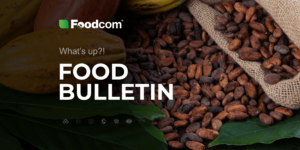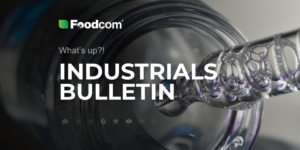- Lysine prices have reached historic lows, and the market remains unstable due to trade tensions and anti-dumping duties.
- Declining demand from China is weakening US exports of feed lactose, increasing price pressure.
- Digital twins are revolutionising animal nutrition, enabling precise and sustainable diet management.
- New feed additives, such as Prosidium and ingredients from insects or algae, offer effective, sustainable alternatives to traditional solutions.
In this edition of our newsletter, we look at the key trends and developments shaping the global feed additives market. From historic lysine price declines and the changing dynamics of the lactose trade, to innovative strategies for managing oxidative stress, the feed industry is undergoing rapid transformation. We also look at new technologies, such as digital twins in animal nutrition, and the growing role of sustainably sourced raw materials. We invite you to read on to find out what is currently driving the feed sector forward.
Lysine
The lysine market in China has reached historically low prices, reflecting a broader correction in the global amino acid market. Buyer activity has dropped significantly as many market participants remain cautious about making deals for the coming quarters. Ongoing trade tensions, currency fluctuations and new anti-dumping measures, particularly in Europe, are contributing to the overall stagnation in the market. While export prices from China and domestic prices in the US remain relatively unchanged, market conditions in Europe have become more volatile. The revised tariffs are putting additional pressure on already low prices, with many buyers preferring to wait until the third quarter before committing.
Lactose (for feed purposes)
The feed lactose market is seeing a marked change in trade dynamics, with a significant slowdown in demand from China, which has previously been the main driver of US exports. This has led to increased supply pressures in the US and falling prices. In contrast, European lactose markets remain in good shape thanks to continued demand from the Chinese food sector, although this good fortune has not spilled over into the feed segment. The outlook for the second half of the year will largely depend on whether US producers manage to find alternative markets or whether demand for feed in Asia begins to recover in the coming months.
Sweet whey powder
Sweet whey powder for feed continues to be under downward pressure due to a seasonal increase in the supply of liquid whey during the spring period in both Europe and the US. The increased supply has caused prices to fall, but this has not yet triggered a corresponding increase in demand. Buyers, especially in Asian markets, remain cautious, which contributes to the downturn. Without a significant recovery in exports or interest in the spot market, the market may continue to gradually weaken in the near term.
Vitamins (E and A)
The global market for feed vitamins remains calm but cautious, particularly for vitamin E and vitamin A. Demand for vitamin E is limited in most regions, with buyers largely unresponsive to slowing production and limited supplier offerings. Prices continue to fall outside the United States, where they remain stable. In the vitamin A segment, oversupply and weak demand persist, with traders holding excess inventory and third-quarter contracts mostly still open. A major producer is expected to resume operations soon and a new supplier may soon enter the market – changes that could alter the current balance if demand picks up.
NEWS
New feed ingredients are gaining popularity as sustainable, high-value alternatives for feeding monogastric animals, offering improvements in both meat quality and environmental impact. Insect meal, microalgae, seaweeds, fermented by-products and bio-enriched cereals have shown promising results in increasing omega-3 fatty acids, antioxidant levels and sensory attributes such as tenderness and flavour in pork and poultry. Although these ingredients support the principles of a circular economy and nutrient recycling, their widespread use faces obstacles such as high processing costs, variability in nutrient content and regulatory complexity. Nevertheless, continued innovation and the increasing openness of farmers suggest great potential for wider implementation in the coming years.
Digital twin technology is rapidly reshaping animal nutrition, enabling precise formulation of diets adapted to complex and dynamic farming conditions. By simulating animals, feed systems or entire farms in a virtual environment, AI-based models allow nutritionists to test myriad scenarios, balancing cost, efficiency, health and sustainability. Companies such as Nutreco are at the forefront of this transformation, developing species-specific digital twins that integrate data on genetics, environment and nutrition economics. Already used in broiler and pig production, these models help optimise outcomes such as growth rate, feed efficiency and environmental impact. As digital twins evolve for different species, they will become essential tools for next-generation animal husbandry management.
Kemin has introduced a new feed sanitiser, Prosidium, which is a modern alternative to formaldehyde, which was banned in Europe in 2018 due to health concerns. The product, unveiled at an event ahead of VIV Asia 2025 in Bangkok, is based on peroxypropionic acid, a compound known for its strong antimicrobial activity and safety profile. Unlike heat treatments or conventional organic acids, Prosidium works quickly – within 30 minutes – to destroy the cell membranes of pathogens without compromising the feed’s nutritional value or palatability. Already approved in Brazil, South Africa and parts of Southeast Asia, the additive is expected to enter the Thai market in the third quarter of 2025, followed by global approvals.
The modern approach to protecting animals from oxidative stress is clearly changing – simply adding vitamin E to the diet is now not enough. There is a growing understanding that most of the harmful molecules (known as free radicals) are formed in the mitochondria, the ‘energy factories’ of cells. Therefore, an effective antioxidant strategy starts right there – by supporting the body’s natural defence enzymes. This is supplemented by readily available trace elements such as selenium, zinc and copper, which activate these enzymes. Only at a later stage do secondary antioxidants such as vitamin E and plant compounds play a role. This multilayered protection better prepares the animals for stress, improves their resistance and promotes better performance under real production conditions.
![What’s up? News from the feed industry! Market overview and analysis [May 2025] What’s up? News from the feed industry! Market overview and analysis [May 2025]](https://foodcom.pl/wp-content/uploads/2025/05/feed-biuletyn-1520x760.png)


![Co nowego w branży chemicznej? Przegląd i analiza rynku [Kwiecień 2025] Co nowego w branży chemicznej? Przegląd i analiza rynku [Kwiecień 2025]](https://foodcom.pl/wp-content/uploads/2025/04/Global-Report-szablon-pod-bloga24-1-300x150.png)



